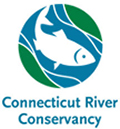The Connecticut River is Nationally Recognized
The Connecticut River is the flagship natural resource for New England, just as the Chesapeake Bay is to the mid Atlantic region. Running 410 miles from the Canadian border to Long Island Sound, it is the region's longest river and one of only 14 designated American Heritage Rivers in the nation recognized for its distinctive natural, economic, agricultural, scenic, historic, cultural and recreational qualities. In May 2012, U.S. Interior Secretary Ken Salazar designated the Connecticut River as America's first National Blueway, saying the restoration and preservation efforts on the river were a model for other American rivers. Click here for more information about America's first National Blueway.
The Connecticut River watershed encompasses 11,260 square miles, connecting 148 tributaries, including 38 major rivers and numerous lakes and ponds. It is home to many wildlife species, including bear, moose, bobcat, wild turkey, bald eagle, trout, shad, and 10 federally threatened or endangered species. It is also home to New England's most productive farmlands and to 2 million human residents, about 84% of whom live in or near urban areas including Holyoke, Chicopee, and Springfield, Massachusetts and Hartford, Connecticut.
Living With Our Industrial Legacy and Combined Sewer Overflows (CSOs)
The Connecticut River like many rivers has been recovering from an industrial legacy that wrought more than a century of damage. Though there have been significant improvements over recent decades, the river is still beset by problems that prevent it from achieving federal Class B fishable/swimmable water quality standards in many locations, particularly below both the Holyoke Dam in Massachusetts and aging infrastructure in the Hartford, Connecticut region. Aged infrastructure that can only be remediated incrementally due to monumental costs continues to deliver pollutants that result in downstream impacts. This includes some 28.7 million pounds of nitrogen (MA DEP, 2011) flowing annually from the Connecticut River into the marine ecosystem of Long Island Sound. Though some of the largest combined sewer overflows (CSOs) have been eliminated and associated contamination reduced by half in the past 15 years, bacteria levels during storm events remain unsafe for swimming and boating. Combined sewers are located in the region's poorest communities which have already seen repeated rate hikes to help cover some of these clean up costs. Congressional earmarks, which had been another important source of funding for these capital intensive projects, are no longer available. Financial pressures are compounded as communities also strive to improve stormwater management, further reducing water quality impacts.
At the same time, affordability and accessibility give the Connecticut River Valley a high potential for economic development and rapid growth. Lands developed for commercial or residential purposes increased by 31% from 1982 to 1997. It is projected that with current trends, 323,000 acres within the watershed will be converted from rural to exurban by 2020. (Trust for Public Land, 2006)
Connecticut River Factsheet Series
Implementing Solutions for a Cleaner River
Fortunately the good working relationships and partnerships that have been forged over the years for the Connecticut River are an asset to addressing many of these issues. Recent investments from the U.S. Environmental Protection Agency, National Oceanic and Atmpshperic Administration, and Department of Housing and Community Development are helping to advance partnership efforts to find creative solutions for improved water quality and ecosystem health on the Connecticut River. Partners in turn are excited by the challenges of transforming practices and behavior and finding viable and sustainable solutions toward respecting and enjoying this great resource.
Connecticut River Projects and Collaborations
Connecticut River Studies and Research
Connecticut River Bacteria Monitoring Data 2012
Connecticut River Bacteria Monitoring Data 2008-2011
Rapid Response Water Quality Monitoring and Public Awareness, 2010
Connecticut River Bacteria Monitoring Project, 2011

